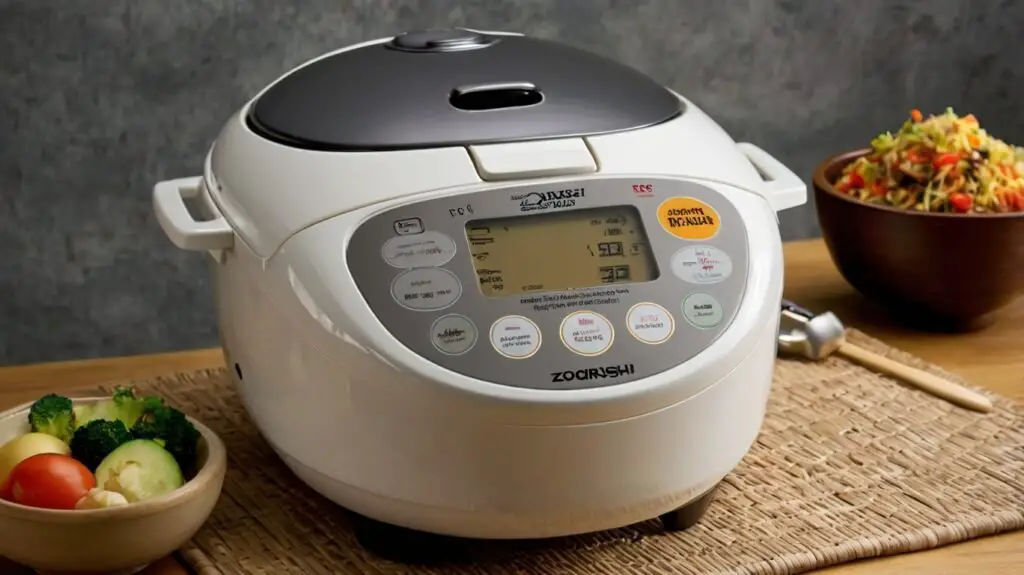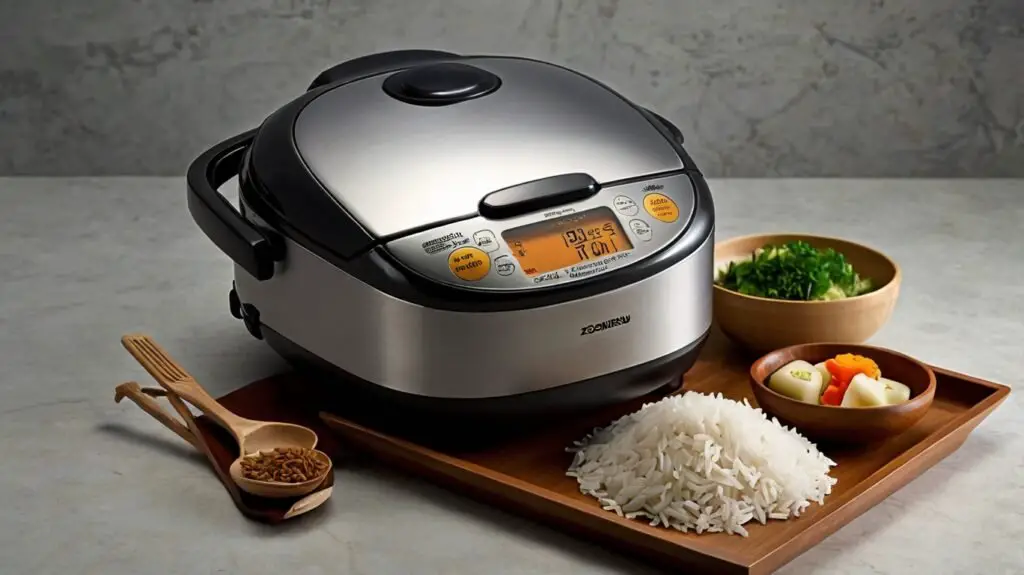As someone who loves cooking rice perfectly, I’ve often found myself torn between two leading brands in the rice cooker market. Zojirushi and Panasonic. After experimenting with both, I noticed distinct differences that made my choices easier or more challenging, depending on how you look at it! Let me walk you through my findings and share what I found out.
Top Rated Zojirushi And Panasonic Rice Cooker:
- Zojirushi NS-ZCC10 5-1/2-Cup Neuro Fuzzy Rice Cooker and Warmer
- Zojirushi NS-TSC10 5-1/2-Cup (Uncooked) Micom Rice Cooker and Warmer
- Zojirushi NS-LGC05XB Micom Rice Cooker & Warmer, 3-Cups
- Toshiba Rice Cooker 6 Cup Uncooked Japanese Rice Cooker
- TOSHIBA Rice Cooker Induction Heating, with Low Carb
- Toshiba Mini Rice Cooker, 3 Cups Uncooked Small Rice Cooker
The Basics: Zojirushi vs. Panasonic
Overview of Zojirushi Rice Cookers
Zojirushi rice cookers are widely loved for their ability to deliver perfectly cooked rice every time. These models offer a rich array of features like fuzzy logic and induction heating. Such technological advancements set them apart in the competitive landscape of rice cookers. They clearly cater to serious cooking enthusiasts. Most Zojirushi products fall in the higher end of the price spectrum, typically ranging from $150 to $400.
Introduction to Panasonic Rice Cookers
On the other hand, Panasonic rice cookers offer practicality at a more affordable rate. Their rice cookers, priced between $70 to $250, cater to various budgets without compromising quality. While they might not offer as many high-end features as Zojirushi, they still deliver consistent results. Panasonic is more accessible to the average household who wants quality without a dent in their budget.
Historical Background of Each Brand
Zojirushi has been innovating kitchen appliances since 1918, with a special focus on rice cookers since the 1980s. This longevity emphasizes their commitment to quality and progression in technology. Conversely, Panasonic, established in 1918 as well, focuses on a broad range of consumer electronics, including kitchen appliances. However, their rice cookers truly gained popularity in the 2000s.
Consumer Reviews and Impressions
On the flip side, Panasonic rice cookers receive praise for their reliability and user-friendliness, making them suitable for families and everyday use.
Comparative Insights
- Zojirushi: High-end features, focused on technology
- Panasonic: Budget-friendly, good quality
- Both brands hold significant shares in the rice cooker market
Ultimately, the choice between Zojirushi and Panasonic comes down to your cooking habits and budget. Each brand brings something unique to the table, catering to different consumer needs.
Price Chart
| Brand | Price Range |
|---|---|
| Zojirushi | $150 – $400 |
| Panasonic | $70 – $250 |

Key Features to Consider
Choosing the right rice cooker can be quite the task. With so many options available, it’s important to focus on key features that will truly enhance your cooking experience. Let’s dive into what you should consider when comparing brands like Zojirushi and Panasonic.
Cooking Modes and Settings
Both Zojirushi and Panasonic rice cookers come equipped with different cooking modes. These features allow you to make a variety of rice types, from jasmine to brown rice, and even porridge. But how many modes do they really offer?
- Zojirushi: Offers up to 10 cooking functions per model, ensuring versatility.
- Panasonic: Typically provides around 5 cooking functions, focusing on simplicity.
Capacity Options
Family size plays a big role in your rice cooker choice. If you often cook for a large group, a larger capacity is essential. Zojirushi provides options that cater to different family sizes, which is particularly beneficial for those who like to meal prep.
Materials in Construction
The materials used in these cookers are very important. Not only do they affect durability, but they also impact how evenly your rice cooks. Look for stainless steel or high-quality plastic that can withstand high temperatures.
Technology Integration
Modern rice cookers have advanced features that adapt cooking based on different factors. Take fuzzy logic technology, for instance. This allows the cooker to adjust cooking time and temperature based on moisture levels. How cool is that? While Zojirushi excels with this technology, Panasonic leans toward simplicity with customizable settings.
Ultimately, understanding these characteristics is vital. Your cooking habits and preferences will dictate which features you need most. If you love experimenting, you’ll likely benefit from a multi-function cooker like Zojirushi. But if your needs are more straightforward, Panasonic could be a great match.
| Brand | Cooking Functions |
|---|---|
| Zojirushi | Up to 10 |
| Panasonic | Around 5 |
In conclusion, comparing features helps you select the best rice cooker according to your needs and cooking style.
Performance Analysis
When choosing between Zojirushi and Panasonic rice cookers, performance is key. Here’s how these two brands stack up in various categories:
1. Cooking Times
How fast can you get your rice ready? Zojirushi cooks rice about 10% faster on average compared to Panasonic. For busy individuals, every minute counts. Imagine being able to serve dinner earlier; that’s a big win!
2. Quality of Cooked Rice
Quality is essential. Zojirushi is often praised for its ability to cook sushi rice perfectly, making it a favorite among sushi lovers. On the flip side, Panasonic rice cookers seem to excel in cooking delicate jasmine rice. Who doesn’t love fluffy and fragrant rice to pair with their meals?
3. User Satisfaction and Reviews
User feedback speaks volumes. According to reviews, Zojirushi boasts an impressive satisfaction rating of 4.8 out of 5, while Panasonic follows with a rating of 4.2 out of 5. That’s a clear indicator of how much people appreciate their rice cookers.
4. Maintenance and Cleaning Ease
Cleaning up is never fun, but it’s a must. Zojirushi models are designed for easy cleaning, often with non-stick interior materials. Panasonic also offers user-friendly designs, but some users note that the steam vent can accumulate residue. A quick rinse after cooking can do wonders, though no one enjoys scrubbing stubborn bits off their appliances!
Overall, both brands show strong performance, but your choice might come down to specific needs. Do you prioritize speed, quality, or user experience? Keep these factors in mind as you decide!
Pricing and Warranty
Price Range Overview for Each Brand
When considering rice cookers, Zojirushi and Panasonic offer a broad spectrum of prices. They cater to various budgets and needs. On the lower end, Panasonic models might start around $50, making them accessible for anyone looking to cook rice without breaking the bank.
On the other hand, Zojirushi usually ranges from $150 to $300. It might sound steep, but I believe the extra cost often reflects advanced technology and features designed for consistent culinary results.
What You Get for Your Money
With Panasonic, you get reliable performance and basic cooking functions, which is great for everyday use. But if you’re someone who wants features like fuzzy logic for precise cooking or a steaming tray, Zojirushi could be your go-to.
This rings true, especially if you’ll be using the cooker daily. I’d say, think about the long-term savings on cooking efforts versus the initial cost.
Warranty Comparisons
Warranty can be a deciding factor. For instance, Zojirushi typically offers a 1-year warranty on most products. This is enough for some, but it raises questions about long-term reliability.
- Zojirushi: 1-year warranty for most models.
- Panasonic: 2-year warranty on select models.
This extended warranty from Panasonic can definitely add value, granting peace of mind for your purchase. After all, we want our appliances to last, right?
Long-Term Value Considerations
Let’s face it: it’s not just about the purchase price. Think about what you’re getting. With Zojirushi, you pay more upfront, but the investment can mean lower energy costs and better rice quality.
Meanwhile, Panasonic tends to offer value-packed options at a reasonable cost. But will it meet your cooking needs over the years? I’d encourage you to evaluate how often you cook rice and what features you truly need.
In the end, the choice between Zojirushi and Panasonic rice cookers really comes down to your cooking habits, needs, and budget. Always pay attention to how price correlates with functionality and longevity; this might just save you money in the long run.

Final Thoughts: Making the Right Choice
As I wrap up this discussion, let’s recap the major points we’ve covered. We’ve explored the features of both Zojirushi and Panasonic rice cookers. Each brand offers unique advantages, depending on how you like to cook. For some, it’s all about consistency. For others, versatility is key.
Understanding Your Cooking Needs
When it comes to choosing a rice cooker, it’s essential to consider your personal cooking needs. Are you a busy professional? Maybe a rice cooker with a delay timer and quick cooking functions is for you. If you enjoy experimenting, a model with various cooking modes might be ideal.
Usage-Based Recommendations
Recommendations are often based on usage types. For daily meals, Zojirushi often shines through its advanced features. On the other hand, if you occasionally cook rice, a Panasonic model could be more budget-friendly. It’s all about how often you plan to use it and what dishes you want to prepare.
The Voices of the Community
Community feedback can provide invaluable insight. When I sifted through reviews, it was clear that users appreciate reliability in their cookers. Many cooks shared their experiences, noting how certain features made their lives easier. Some applauded Zojirushi for its rice quality, while others favored Panasonic for its affordability and ease of use.
This quote resonates deeply. Ultimately, the right choice relies heavily on individual cooking habits and budget. Understanding what works for you is more crucial than choosing the most expensive model. Gather feedback from fellow chefs and home cooks they often provide insights that you might not find in product descriptions.
As you consider your options, think about what you’ve learned here. Reflect on your cooking habits and preferences. Your rice cooker should be an investment into your culinary journey, making meal prep simpler and more enjoyable.
In the end, it’s about finding that perfect match between functionality and your lifestyle. Good luck on your quest to find the best rice cooker for your kitchen!
TL;DR: Zojirushi and Panasonic rice cookers each have unique features that cater to different cooking styles and preferences. Understanding these distinctions will help you make an informed choice for your kitchen.
